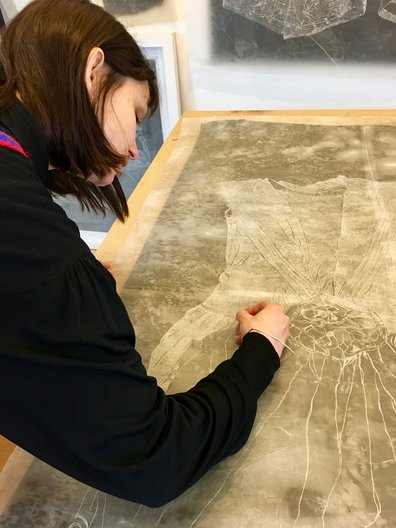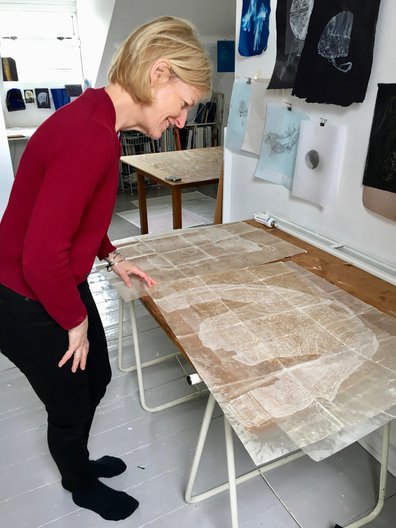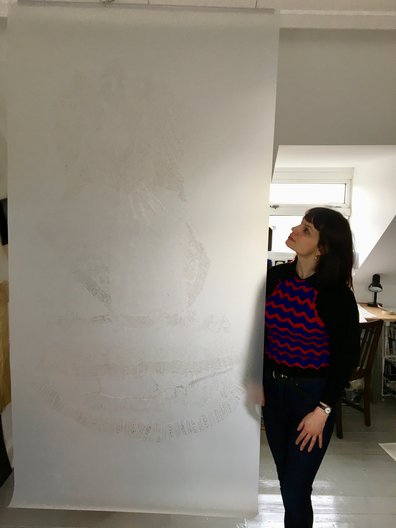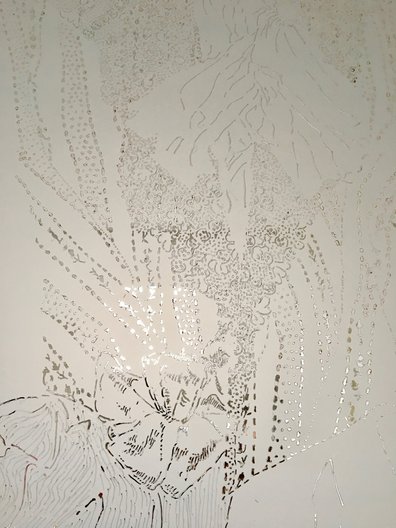1 May 2018
by Sarah Casey and Ingrid Mida
In this second blog post, Sarah Casey and Ingrid Mida, research partners on an AIDF funded project, discuss Sarah’s progress in transforming her site drawings of artifacts from the Ryerson Fashion Research Collection into works of art.
In April 2018, Ingrid Mida travelled to the UK to visit Sarah studio in Lancaster. She made three visits over three consecutive days to look at how the work had developed since Sarah’s visit to Toronto.
Ingrid: Tell me about what happened when you came back to the studio with your drawings from Ryerson?
Sarah: When I came back to the studio one of the questions I had to answer is how can I make a drawing that captures the experience of viewing the artefacts I studied at Ryerson. The pencil drawings made on site accurately capture a visual likeness and from this I want to make artworks that convey the feeling of touching the fabric. I try to achieve this by finding a technique of drawing that produces a surface that looks and feels like the garments I studied.
Ingrid: What are you aiming to achieve in trying different materials?
Sarah: My drawings rely on a sympathetic choice of materials– this means that the material qualities of the drawing echo the material and textural conditions of the subject.
It is not always obvious how to achieve this and it can take many tests or trials to work out what materials and supports are right for the subject. For instance, I might be thinking about weightlessness and looking for a translucent surface so I need to find which tissue can be made transparent and support a mark and that has the right degree of visibility – not too vivid, not too obscure.
This searching for likeness is not just related to the material and visual properties, conceptual considerations also come into play. For instance, in the drawings of artifacts received in plastic bags, these images have been made by burning holes in plastic drafting film. This process refers to the absence of any provenance about the wearer, and to the way the garments entered the collection, and the aesthetic effect is one of a ghostly absence.
Ingrid: Can you say about more about how you make these material tests?
Sarah : I spend time on material tests using paper scraps as a way to explore the relationship between the drawing and the medium on which it would be presented. Given the time involved in resolving a full-scale work, I experiment with a small part of the image, or even just a collection of abstract marks on a page. I am a careful archivist of the tests – many are undertaken in a series and are layered with multiple processes – drawn with one material then coated in another such as oil, wax or ink. This produces multiple variants on a theme. I collect these in folders and notebooks, labeled with the process. In the past I have kept a ‘recipe book’ of fragments to keep track of them. It has proved to be a really useful resource for thinking about how to approach new subjects.
Ingrid: Sometimes your work is highly detailed and other times you seem to want to obscure the line work as with the rubbings and calotypes. Are these choices linked to ways of seeing or the fading of memory?
Sarah: Yes, very much so. The sense that something is just out of reach, or may fade from view. I am aware of not simply illustrating a picture of the artifact. I want the drawing to embody the sensory and emotional experience of viewing garments in a collection and to convey the poignant sense of an absent presence. This oscillation between figuration and abstraction is an attempt to create an image that is adequate to that sensation, of seeming both there and not there.
Ingrid: How do you know when the work is ‘finished’?
Sarah: This is a tricky question. By the time I get to making a full-scale work – say a life-sized rendering of a woman’s dress with a train– I have often got a clear picture in my head of how I envisage the completed work. Most of my work is a very systematic drawing process that draws on the legacy of 1960s American minimalist drawing, in that I start a drawing with a fixed process in mind and I simply follow it through to completion. For other pieces, I may work in a series, so it is over a course of making several related works that they come to feel finished. What I mean by this is that they start to make sense, as the image, process, and support come together in a way that conveys the meaning I am after. At the moment, the drawings focused on two processes one for each of the two groups of garments we studied. Each will be finished, when all the garments are drawn.
Ingrid: Why are some works framed and others hung with simple clips? You seem to prefer minimal hanging supports. Does this resonate with your work in some way?
Sarah: The decision to frame or not frame is sometimes practical one, based on the exhibition space. It is also an important part of the work itself. I typically like the work to be unframed since this offers the viewer a more direct material engagement with the drawing. The work then has a sense of vulnerability. In the past, drawings generally were viewed unframed and would be handled in a very intimate setting. This is a way of looking that is somewhat similar to viewing garments in a fashion archive. I also like that an unglazed surface offers the possibility of touch to a viewer, but one that must be resisted. That tension, between attraction and denial, interests me very much as it conveys the nature of delicacy that echoes the delicacy of both the garments and the drawings.
Ingrid: Some of the works are made on cheap paper like newsprint or are folded which potentially risks compromising the paper and hastening its decay. You seem to welcome this risk. What are you saying about your work with such choices?
Sarah: These choices are part of finding a likeness with the subject. I know my choices make become a conservator’s nightmare, but if I am drawing artifacts that are subject to the ravages of time and exposure to light, I want my drawings to embody this.
I became aware several years ago that there is an interesting opposition in the role of the conservator and artist. While archival artifacts are cared for so that they are not marked or degraded by the damaging effects of touch, the artist is actively seeking to mark a surface through touch. This led me to draw with light and oil, inverting conservational measures. While you were in my studio we looked at work from my exhibition at the Bowes Museum in 2015. When I made these drawings, they were transparent but they have now yellowed and aged, which suggests that they have a life of their own, running in parallel to that of artifacts they depict.
I am interested in how drawings can reflect the precarious balance in which some historical garments exist, seemingly perched between preservation and decay. I mirror this in drawing on wax so that if the drawings get too hot, they would simply melt away. I am quite excited at this possibility in relation to our project on dead objects.
Sarah: Do you want to explain the concept of dead objects?
Ingrid: The idea of a dead object in museological terms is sometimes used to describe an object that has disintegrated to a point that it cannot be safely handled. One of the objects I presented to you as a provocation, a wedding dress from 1927, was not accessioned into the collection because it was in very poor condition. I hesitated to discard it because it was one of several garments that had belonged to the same woman and the family had provided photos and other contextual material. Instead of discarding it, I presented it to you as a provocation for creative work.
Ingrid: Some of the work is not even visible without a certain type of light. Why do you make it hard for the viewer to see your beautiful marks?
Sarah: Thank you , I do not really think of the marks as being beautiful, per se – in fact some are really quite crude. I actually wonder if part of what makes them attractive is the way the image flickers in and out of view like a mysterious presence that is a bit beyond our grasp. Perhaps that is where the beauty lies. Crispin Sartwell writes in Six Names Of Beauty that ‘the very possibility of beauty depends on its temporal boundedness and fragility’ (Sartwell, 2004, pxiii). I think this is what the work aspires to achieve in terms of aesthetics. This is beauty as an awareness of our vulnerability and an aesthetic that recalls the qualities of the subject matter. Clothing as metaphors for the ephemerality of human presence and life.
This is why the experience of working with you at the Ryerson Fashion Research Collection has been so valuable. The concept of ‘dead objects’, which you introduced me to, has been a stimulating provocation. To have the opportunity to examine and draw these dead artefacts first hand has resulted in developing new ways of making drawings that I wouldn't have considered before.





